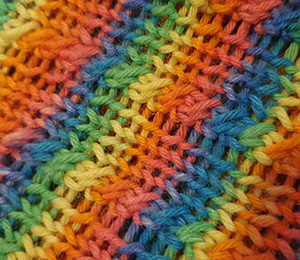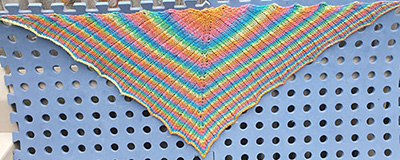Cabley

Making triangle shawls are lovely, especially if you have striping yarn, but it's often a choice between just endless stocking stitch or really complicated lace patterns. So I wanted to make something that was relatively easy but still kept my attention.
This was done with a generic ball of acrylic I picked up from somewhere because I liked the bright rainbow striping, but, really, any yarn and needle size will do, as long as you like knitting with it as you go.
You'll need to know how to pick up stitches, how to make-1-left (m1l) and make-1-right (m1r), and how to do a simple cable to the front (c1f). If you can do cabling without needing a cable needle, that makes it even easier, because you won't need to be switching between needles every few stitches.
Items needed:
- 1 ball of double-knit (DK) yarn — or any yarn of your choice
- 4mm/6 (US)/8 (UK) circular needles (or whatever size you want to use)
- 4 stitch markers
- Row counter
Tension
Tension doesn't matter too much, just make sure you can easily do the increases and cables.

Pattern
Cast on 2 stitches.
Knit 6 rows.
Pick up and knit 3 stitches along the right edge, knit the 2 main stitches, pick up and knit 3 stitches along the left edge. You have 8 stitches now.
Knit 2, place marker, make 1 right, knit 1, make 1 right, place marker, knit 2, place marker, make 1 left, knit 1, make 1 left, place marker, knit 2. The markers indicate the edges, body, and centre stitches.
Knit 2, purl until the last stitch marker, knit 2.
Use the row counter to keep track of the body stitches. On every knit row, it'll increase by 2 (2, 4, 6, 8, 10, 12, etc.).
These two rows make up the pattern:
Knit 2, make 1 right, knit 1, cable 1 stitch to the front, knit 1, make 1 right, knit 2, make 1 left, knit 1, cable 1 stitch to the front, knit 1, make 1 left, knit 2.
Knit 2, purl until the last stitch marker, knit 2.
You'll alternate the cable with two stocking stitches.
So, for example, when you reach 20 stitches on each body, the right will look like this:
M1r, k2, c1f, k2, c1f, k2, c1f, k2, c1f, k2, c1f, m1r.
And the left will look like this:
M1l, c1f, k2, c1f, k2, c1f, k2, c1f, k2, c1f, k2, m1l.
Keep going until you reach the length you want, then cast off as normal.
Block to ensure good definition and enjoy!